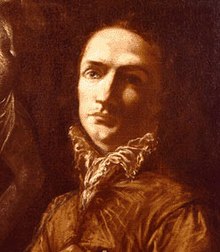Giovanni Antonio Burrini
Appearance
This article has an unclear citation style. (June 2018) |
Giovanni Antonio Burrini | |
|---|---|
 Self-portrait | |
| Born | April 25, 1656 Bologna, Italy |
| Died | January 5, 1727 (aged 70) Bologna, Italy |
| Nationality | Italian |
| Known for | Painting |
Giovanni Antonio Burrini (25 April 1656 – 5 January 1727) was a Bolognese painter of Late-Baroque or Rococo style. After an apprenticeship with Domenico Maria Canuti, he went to work under Lorenzo Pasinelli with fellow student, Giovanni Gioseffo dal Sole. He became an early friend and often close collaborator with Giuseppe Maria Crespi, with whom he shared a studio. He became a rival and competitor with Sebastiano Ricci. He painted in Turin for the Carignano family and Novellara.[1] In 1709, he was one of the founding members of the Accademia Clementina in Bologna.
His daughter Barbara Burrini was also a painter. Among his pupils was Bartolomeo Mercati.[2]
Partial anthology of works
- Joseph Interpreting Dreams (Muzeum, Warsaw)
- Samson and Delilah
- Martyrdom of Saint Victoria
- Fresco Cycle (Villa Albergata, Zola Predosa)
- Martyrdom Of Saint Euphemia (1686, Chiesa Saint Euphemia, Ravenna)
- Frescoes (Palazzo Ruini, Bologna)
- Frescoes (San Giovanni Battista dei Celestini, Bologna)
- Susannah and the Elders (Pinacoteca, Bologna)
- Sacrifice of Isaac (Louvre, Paris)
- Orpheus and Eurydice (1697)
- Frescoes (1695, San Bartolomeo, Bologna)
- Martyrdom Of Saint Catherine (Santa Caterina di Saragozza, Bologna)
- Immaculate Virgin with Saints Petronius & Dionysius the Areopagite (1684, Chiesa Parrocchiale, Monghidoro)
- Adoration of the Magi (Fogg Art Museum, Cambridge, Massachusetts)
- Bacchus and Ariadne (Private Collection)
- Herminia and the Shepherds (Pinacoteca, Bologna)[1]
- Infant Jesus, Saint Joseph, and three saints (Louvre) [2]
References
- Francis P. Smyth and John P. O'Neill (Editors in Chief) (1986). National Gallery of Art, Washington DC (ed.). The Age of Correggio and the Carracci: Emilian Painting of the 16th and 17th Centuries. pp. 385–391.
{{cite book}}:|author=has generic name (help) - Grove Art encyclopedia abstract
- ^ Lanzi, Luigi (1847). Thomas Roscoe (translator) (ed.). History of Painting in Italy; From the Period of the Revival of the Fine Arts to the End of the Eighteenth Century. Vol. III. Henry G. Bohn, Covent Garden, London; Original from Oxford University Digitized Jan 31, 2007. p. 147.
{{cite book}}:|editor=has generic name (help) - ^ Guida del forestiere per la città di Bologna e suoi sobborghi, by Girolamo Bianconi; Bologna; 1820; page 516.
External links
Wikimedia Commons has media related to Giovanni Antonio Burrini.
